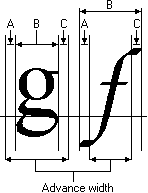Character Widths
Applications need to retrieve character-width data when they perform such tasks as fitting strings of text to page or column widths. There are four functions that an application can use to retrieve character-width data. Two of these functions retrieve the character-advance width and two of these functions retrieve actual character-width data.
An application can use the GetCharWidth32 and GetCharWidthFloat functions to retrieve the advance width for individual characters or symbols in a string of text. The advance width is the distance that the cursor on a video display or the print-head on a printer must advance before printing the next character in a string of text. The GetCharWidth32 function returns the advance width as an integer value. If greater precision is required, an application can use the GetCharWidthFloat function to retrieve fractional advance-width values.
An application can retrieve actual character-width data by using the GetCharABCWidths and GetCharABCWidthsFloat functions. The GetCharABCWidthsFloat function works with all fonts. The GetCharABCWidths function only works with TrueType and OpenType fonts. For more information about TrueType and OpenType fonts, see Raster, Vector, TrueType, and OpenType Fonts.
The following illustration shows the three components of a character width:

The A spacing is the width to add to the current position before placing the character. The B spacing is the width of the character itself. The C spacing is the white space to the right of the character. The total advance width is determined by calculating the sum of A+B+C. The character cell is an imaginary rectangle that surrounds each character or symbol in a font. Because characters can overhang or underhang the character cell, either or both of the A and C increments can be a negative number.